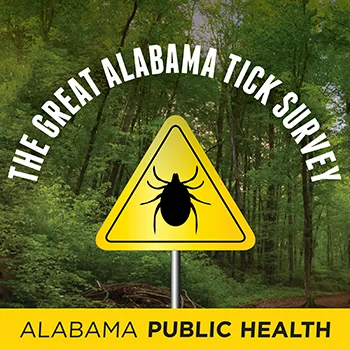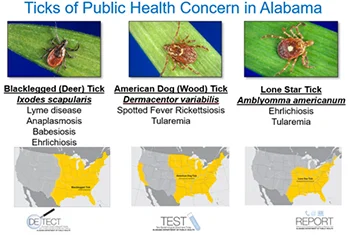Tick-borne Diseases

Tick-borne diseases are transmitted to a person from the bite of an infected tick. Some common ticks in Alabama are the Blacklegged (Deer), American Dog (Wood), and Lone Star. Ticks typically dwell in grassy, brushy, or wooded areas. Although they are more active in the early spring and late fall months, tick-borne illnesses have been reported year-round in Alabama. It is vital to remain vigilant by conducting tick checks whenever you return from the outdoors. For more information, look below on how to prevent and remove ticks.
For more information on tick-borne disease case counts, see our Data page.
Diseases
Ticks can transmit different diseases, but the most common under surveillance in Alabama include:

There are other rare tick-borne diseases of public health concern reported in Alabama that include:
- Tularemia
- Babesiosis
- Powassan Virus
- Alpha-gal syndrome
- Typhus fevers
Symptoms
Early symptoms of tick-borne diseases can be variable, but often include fever, muscle aches, headaches, fatigue, and/or rash. Sometimes, tick-borne diseases may become severe or even life-threatening if not treated. For example, untreated spotted fever rickettsiosis may lead to encephalitis, shock, seizures, gangrene, and/or acute respiratory or renal failure within a week of becoming sick. Untreated Lyme disease may cause arthritis as well as various neurologic and cardiac problems days to months after first becoming ill.
Treatment
If you think you may have a tick-borne disease, see your doctor immediately. He or she will evaluate your symptoms, exposure history, and test results to determine your best treatment course. Most tick-borne diseases are easily treated with antibiotics; early treatment can help you avoid serious complications.
Prevention
You can lower your risk of getting a tick-borne disease while outdoors by:
- Avoiding wooded and brushy areas where ticks tend to live:
- Walking in the center of trails
- Using repellent that contains at least 20% DEET, picaridin, or IR3535 on exposed skin
- Treating clothes with 0.5% permethrin
- Finding and removing ticks from your body and clothing within 2 hours of coming indoors
To safely remove a tick attached to your skin:
- Use tweezers to grasp the tick as close to the skin's surface as possible.
- Pull upward on the tick with steady, even pressure. Do not twist or jerk the tick.
- Dispose of a live tick by submerging it in alcohol, placing it in a sealed container, or flushing it down the toilet.
- Clean the bite area and your hands with soap and water, rubbing alcohol, or an iodine scrub after removing the tick.
The CDC has developed the Tick Bite Bot, an interactive tool to assist individuals in removing attached ticks and determining when to seek healthcare after a tick bite. The online, mobile-friendly tool asks a series of questions covering topics such as tick attachment time and symptoms. Based on the user's responses, the tool then provides information about recommended actions and resources. Find more information at the CDC Tick Bite Bot.
General Resources
Page last updated: December 10, 2025




